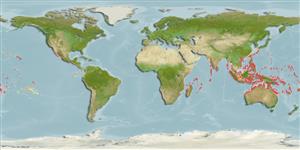Preferred temperature (Ref.
123201): 25.2 - 29.3, mean 28.4 °C (based on 2764 cells).
Índice de diversidade filogenética (Ref.
82804): PD
50 = 0.7500 [Uniqueness, from 0.5 = low to 2.0 = high].
Bayesian length-weight: a=0.01995 (0.00956 - 0.04164), b=2.93 (2.76 - 3.10), in cm total length, based on LWR estimates for this (Sub)family-body shape (Ref.
93245).
Nível Trófico (Ref.
69278): 2.7 ±0.44 se; based on food items.
Resiliência (Ref.
120179): Elevada, tempo mínimo de duplicação da população menor que 15 meses (Preliminary K or Fecundity.).
Fishing Vulnerability (Ref.
59153): Low vulnerability (10 of 100).
Nutrients (Ref.
124155): Calcium = 91.9 [39.7, 238.6] mg/100g; Iron = 0.901 [0.405, 2.114] mg/100g; Protein = 17.9 [15.6, 20.1] %; Omega3 = 0.11 [0.05, 0.23] g/100g; Selenium = 27.5 [12.9, 64.2] μg/100g; VitaminA = 72 [20, 274] μg/100g; Zinc = 1.79 [1.13, 2.88] mg/100g (wet weight);
